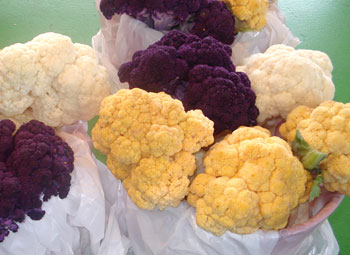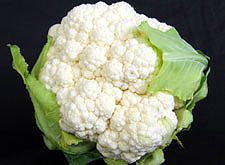
© Paula Trites
Cauliflower belongs to the cabbage family. Though its name means “cabbage flower”, it is not just a flowering cabbage. It is formed from natural flowers on the cauliflower plant which have been encouraged over centuries to gather together and create a large mass of what is called “florets” or “curd.” It has also been described as looking like a bridal bouquet. The white part is called the curd. If left to grow on its own, the curd will be a light green. Farmers, however, fold and tie the leaves of the plant over the curd to keep the sun off it to blanch it. (Varieties have now been developed where the leaves fold over on their own, saving this work.)
Brown spots on cauliflower that you purchase in stores have likely resulted from moisture or condensation on the cauliflower; if the rest of the cauliflower is fine, just scrape these off. Yellowish spots, however, may indicate that the vegetable is quite old and is starting to decay.
These days, you are very likely to see cauliflower served raw on a crudité platter. You mustn’t say anything to the host; just resolve that you will never inflict the same on your guests.
If the cauliflower is young, it is also delicious just steamed or microwaved and served with butter. One of the tastiest ways of serving cauliflower comes from India, as a curried dish. In some areas of Italy, lightly-cooked cauliflower is combined with garlic, olive oil and capers. Breaded and fried cauliflower is also nummy, as is cauliflower served with a lemon butter sauce with chives. It is also great as the base for a thick, hearty soup.
Cauliflower should not be planted near runner beans, spinach or tomatoes.
When buying, avoid cauliflower with yellowing spots or wilted leaves. The florets should be tightly closed, not open.
Cooking Tips
Cauliflower
Denzil Green
To prepare cauliflower, remove the leaves and cut out and discard the stalk and core. Then cut the cauliflower into small or medium-sized chunks, depending on what you are going to be using it for. Wash the florets.
You want to cook cauliflower as little time as possible to preserve the nutrients and maintain a good texture, but also because longer cooking times develop that cabbagey smell that lingers in your kitchen. As well, the longer you cook cauliflower, the more it breaks down and the more watery it becomes. It does, however, need some cooking time to develop what flavour it does have.
Adding a teaspoon of lemon juice to the cooking water will help keep the cauliflower very white.
For the French method of cooking cauliflower white, see the entry for “Au blanc.”
Cooking times for cauliflower
- Pressure cooker: fresh cauliflower 2 to 3 minutes on high pressure. For frozen cauliflower, 2 minutes on high for tender, 3 minutes for soft.
- Steaming: between 12 and 15 minutes;
- Microwaving: 8 to 10 minutes.
Nutrition
Cauliflower is high in vitamin C, folic acid and fibre.
A Cornell University study found that microwaving cauliflower was the best cooking method for preserving nutrients. These are the results they found for preserving Vitamin C in 100 g of cauliflower:
- After boiling, 55 mg of vitamin C remained;
- After steaming, 70 mg of vitamin C remained;
- After microwaving, 82 mg of vitamin C remained.
Equivalents
1 head = 4 cups
Medium head = 2 pounds (900g)
Large head = 3 pounds (serves four).
1 pound (450 g) trimmed Cauliflower = 1-½ cups florets = 7 ½ oz cooked
10 oz (280 g) frozen Cauliflower = 2 cups
1 large head (1.3 kg), steamed and puréed = 2 litres (4 cups / 2 quarts) puréed
1 large head (1 kg), unpeeled = 675 g (6 cups chopped) after peeling and stalk removed
Storage Hints
Store unwashed either unwrapped or in a perforated plastic bag in refrigerator for up to five days. After that, it will develop a strong odour.
Freezing Cauliflower
Cauliflower can be successfully stored as a high-quality frozen product.
Remove leaves, chop florettes into 3 cm (1 inch) pieces. Wash.
The cauliflower is then blanched to destroy spoilage enzymes which would cause the product to deteriorate even though frozen.
You may water or steam blanch.
- Water-blanching: Blanch for 3 minutes in boiling water (no salt needed.) Optional: a few tablespoons of lemon juice in water to keep florets very white. Start timing from when the water comes back to a full boil after adding cauliflower. OR
- Steam-blanching: Blanch for 5 minutes. Start timing from when pot has filled with steady steam again after adding cauliflower. Nothing is needed in the steaming water.
Regardless of how you blanched, plunge in cold water, drain, package, and freeze.
Notes
- Steam blanching has the advantage of saving water and cooking fuel (as less water is needed, and consequently less energy to heat that water), as well as saving time, as the come back up to “speed” time when cold cauliflower is added is faster with steam than a large pot of water.
- To be clear, the blanching is not required for safety, but it is required for quality. Unblanched frozen cauliflower will turn an unappealing brown and go mooshy.
History Notes
Cauliflower originated somewhere around the Mediterranean or Asia Minor. The Egyptians were growing it in 400 BC. The Romans grew it.
Cultivation of it was pretty much restricted to the Italian peninsula until the 1500s, at which time it made its way up into France, and over to America in the 1600s, though it was not developed commercially there until about the 1920s.
Sales of cauliflower fell 35% in the UK during the period of 2001 to 2011. In response, growers have begun growing brightly-coloured varieties to be sold in mixed rainbow packs, in an attempt to revive consumer interest in the vegetable.
Literature & Lore
“Training is everything. The peach was once a bitter almond; Cauliflower is nothing but cabbage with a college education.” — Mark Twain.
Language Notes
“Cauliflower” comes from the Latin words caulis (cabbage) and floris (flower). In French, that became “cole florie”, which became our word “Cauliflower”.
Some people pronounce the word “call-a-flower”; others will say it “call-ee-flower”.
Sources
Eat your greens… and pinks and yellows: How Tesco is trying to get children to eat cauliflower by making it more colourful. London: Daily Mail. 1 August 2011.


